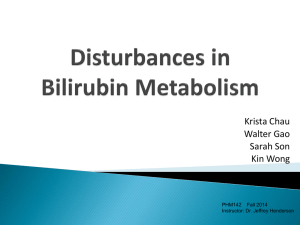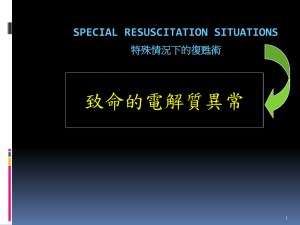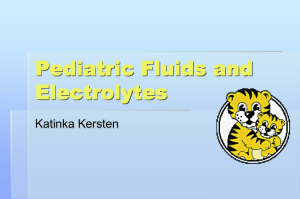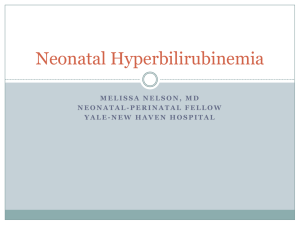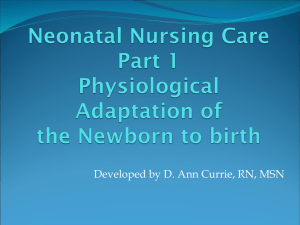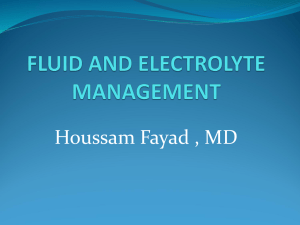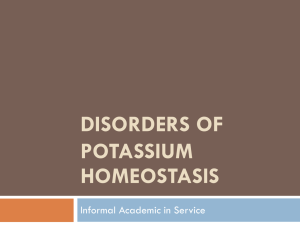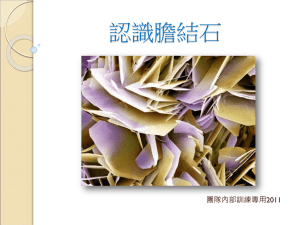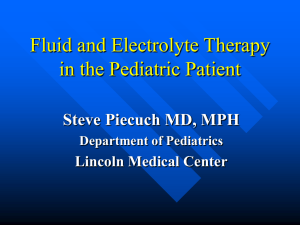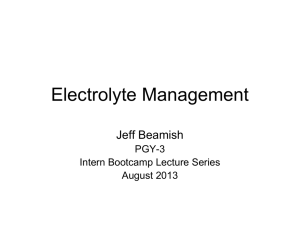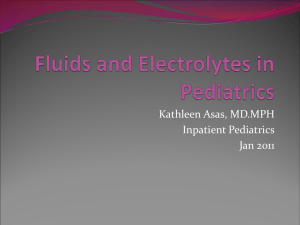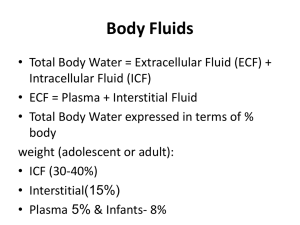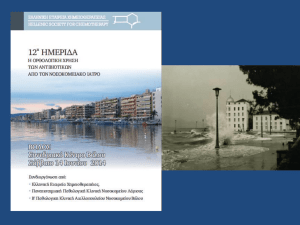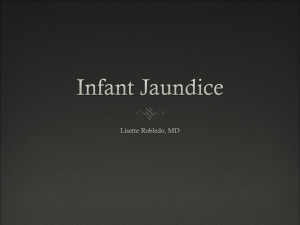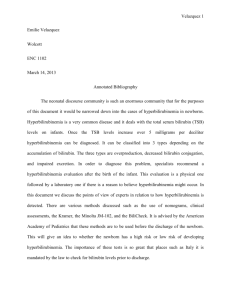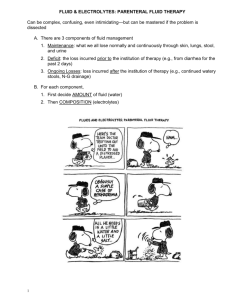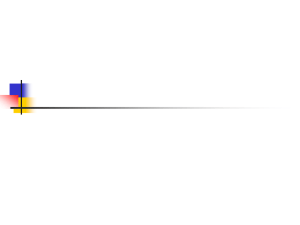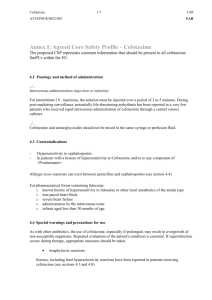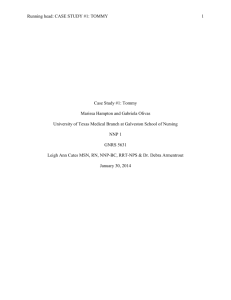What is there to Know About a Yellow Baby?
advertisement
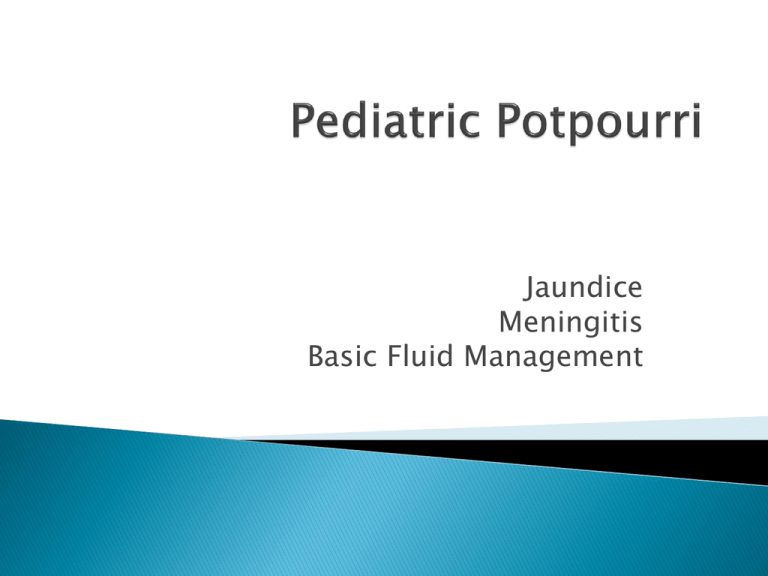
Jaundice Meningitis Basic Fluid Management To be able to thoroughly evaluate and treat Hyperbilirubinemia To be able to recognize meningitis and treat Understand and calculate daily maintenance fluid volume needs for a well child. Understand and calculate daily maintenance sodium and potassium needs for a well child Estimate and replace fluid and electrolytes in the dehydrated child Hyperbilirubinemia was more of a problem prior to Rhogam approval in 1968. Since, the use of Rhogam Hemolytic Disease of the Newborn (HDN) has dramatically decreased. We no longer see the high bilirubin levels that necessitate double volume exchange transfusion. Kernicterus •Unconjugated bilirubin encephalopathy •Three Clinical Phases •hypotonia, lethargy, poor suck in the first day or so •hypertonia +/- opisthotonus towards the end of the first week when there is often also a high-pitched cry , fever and seizures •then a third phase when the baby again becomes hypotonic • Survivors tend to have choreoathetoid cerebral palsy and hearing impairment. ASSESS An Infant’s Risk It’s not just the Bhutani Nomogram and Bilitool Family History Pregnancy History Birth History Feeding History Stooling History Weight Loss Sepsis Risk Time of Onset of Jaundice Newborn Bilirubin Results Family History of Jaundice Cystic Fibrosis G6PD Other Blood Disorders or Hemolytic Processes Ethnicity Blood Type Rh Isoimmune Antibodies Maternal Diabetes Hepatitis Gestational Age Birth Trauma In’s and Out’s and Other Vitals Weight Loss-Calculated as % decreased from Birth Weight Feeding History-Latch,Frequency,Interest Stool color, frequency, and passage of meconium in the first 24 hours REMEMBER JAUNDICE IN THE FIRST 24 HOURS IS NEVER NORMAL Direct Hyperbilirubinemia needs further investigation Direct Hyperbilirubinemia >2mg/dl or >10% of the total serum bili When using this nomogram, remember that "risk" refers to the risk of a subsequent bilirubin level in that infant >95%ile for age. Hour-specific Nomogram for Risk Stratification Infants age 36 hours Total bilirubin 12.9 mg/dl Risk zone High Risk Risk zone is one of several risk factors for developing severe hyperbilirubinemia. Please see AAP Phototherapy Guidelines below. If phototherapy threshold IS exceeded, please also review AAP Guidelines for Exchange Transfusion. If phototherapy threshold IS NOT exceeded, please see recommended follow-up in sidebar to the right. AAP Phototherapy Guidelines (2004) Neurotoxicity risk zone Start phototherapy? Approximate threshold at 36 hours of age Lower Risk (>= 38 weeks and well) No 13.6 mg/dl Medium Risk (>=38 weeks + neurotoxicity risk factors OR 35 to 37 6/7 weeks and well) Yes 11.7 mg/dl Higher Risk (35 to 37 6/7 weeks and neurotoxicity risk factors) Yes 9.6 mg/dl A follow-up bilirubin is recommended in 612 hours if known hemolysis by direct Coomb's or ETCO (end-tidal carbon monoxide) and otherwise recommended within 24 hours (high risk) Maximum Rate of increase in bilirubin for an infant with a non-hemolytic process is 5mg/dl/24 hours or 0.2mg/dl/hr This is helpful to calculate because if you are fortunate to have a previous bili level then at a level greater than or close 0.2mg/dl/hr you will reach light level. CBC with diff and peripheral smear Reticulocyte Count Coomb’s Electrolytes Albumin LFT’s If history warrants, sepsis work-up Adequate Hydration Additional Labs Phototherapy Repeat Bilirubin Fever Irritability Nausea Vomiting Headache Myalgia Back Pain Photophobia Bulging Fontanelle in Infants Irritable Stiff Neck Positive Kernig and Brudniski Sign CSF finding Viral Leukocytes/ < 1000 mm3 Polymorphon 20–40% [b] uclear cells Protein N or < 100 (mg/dL) Glucose N[c] (mg/dL) Blood-toN glucose ratio Bacterial > 1000[a] Partially Treated Bacterial > 1000 > 85–90% > 80% < 10% < 10–20% < 10–20% > 100–150 60–> 100 < 100 > 100–200 > 200–300 UD to < 40 < 40 N < 40 < 40 < 0.4 < 0.4 N < 0.4 < 0.4 Positive smear[d] Positive culture PCR or other methods − > 85%[e] ≥ 80% − < 40% < 30% Rare > 95% < 90% − > 30%[f] < 30% 16S RNA, bacterial DNA Borrelia Histoplasma Mycobacteriu burdgorferi and m antibodies Cryptococcu tuberculosis s antigen, Enterovirus, 16S RNA, herpesvirus bacterial DNA Lyme < 500 Fungal < 500 TB < 300 India ink for Cryptococcu s [b] Bacteria Neisseria meningitidis Antibiotic of Choice Penicillin G or ampicillin Other Useful Antibiotics Cefotaxime or ceftriaxone Haemophilus influenzae Cefotaxime or ceftriaxone Ampicillin or chloramphenicol[a] Streptococcus pneumoniae[b] 1. Penicillin-susceptible (MIC Penicillin G or ampicillin < 0.1 μg/mL) 2. Penicillin-intermediate Cefotaxime or ceftriaxone (MIC = 0.1–1.0 μg/mL) with/without vancomycin Cefotaxime or ceftriaxone 3. Penicillin-resistant (MIC = Cefotaxime or ceftriaxone[c] 1.0 μg/mL) plus vancomycin 4. CephalosporinCefotaxime or ceftriaxone[c] nonsusceptible (MIC > 0.5 plus vancomycin μg/mL) Cefepime or meropenem Listeria monocytogenes Ampicillin ? gentamicin Streptococcus agalactiae Penicillin G ? gentamicin Trimethoprimsulfamethoxazole Ampicillin ? gentamicin Enterobacteriaceae Cefotaxime or ceftriaxone Cefepime or meropenem with/without aminoglycoside Pseudomonas aeruginosa Ceftazidime + amikacin Cefepime or meropenem Add rifampin to antibiotics of choice Meropenem + vancomycin (see text) New fluoroquinolonesd Cefepime or meropenem Supportive Care with fluids (TREAT Shock!), antiemetic (Zofran) Cefotaxime/Ceftriaxone Vancomycin dosed at 60mg/kg/day/q6 Adjunct therapy with dexamethasone at 0.60.8mg/kg/day/BID-TID. Needs to be administered before or during first dose of antibiotics Streptococcus pneumoniae 10-14 days Neisseria meningitidis 4-7 days Haemophilus influenzae 7-10 days Seizures Infarctions Septic Shock Subdural Effusions Prolonged Fevers Hearing Loss Sugar Water Salt Shock or acute deficits Maintenance ◦ Treat shock or dehydration first ◦ Calculate fluid and electrolytes for normal situations. Adjustments ◦ Adjust for or fluid or electrolyte needs. Reassess therapy regularly Isotonic Solution-Normal Saline/Lactated Ringers Bolus 20cc/kg Bolus to perfusion and clinical improvement If no improvement after the third bolus reassess and other fluids or pressors Holliday-Segar Method This method is based on the assumption that for every 100 calories metabolized 100ml of water is required. This method is based on metabolic rate. THIS METHOD DOES NOT WORK FOR INFANTS LESS THAN 14 DAYS OLD Weight = Kilocalories expended = Volume (ml) of H2O needed Weight kcal / 24hr cc / 24 hr Infant < 10 kg (4) 100 kcal / kg 100 cc/kg Child 10-20 kg (2) 1000 kcal + 50 kcal per kg over 10 1000cc+ 50cc/kg For each kg 20-80 (1) 1500 kcal + 20 kcal per kg over 20 1500cc+20cc/kg Max ~2400 cc/day (~100 cc/hr)*** Sodium 3 mEq / 100 kcal (100 ml fluid) = 30 mEq NaCl / L Potassium 2 mEq/100 kcal (100 ml fluid) = 20 mEq KCl / L 50 grams dextrose per 1000 ml water Glucose is the principle nutrition for the brain, heart and red blood cells. • 5% Dextrose (metabolizes to glucose) provides adequate short term nutrition in the resting state (20% of caloric RDA). We need Sodium 3 mEq per 100 ml = 30 mEq NaCl / L We have: Normal Saline ½ NS ¼ NS (0.9% NaCl) (0.45% NaCl) (0.2% NaCl) = 154 mEq/L = 72 mEq/L = 34 mEq/L Potassium 2 mEq/L per 100 ml = 20 mEq/L Order: D5 ¼ NS with 20 meq KCl/L for maintenance fluid Why then is Everyone writing for 1/2NS or NS on the Pediatric Wards? Many sick patients need more than ¼ NS (0.2% NaCl). They are at risk for hyponatremia with hypotonic fluid. Due to Elevated Anti-Diuretic Hormone (ADH). ◦ Infection ◦ Drugs ◦ Hypovolemia ◦ Neurologic disease ◦ Pain / anxiety ◦ Surgery / anesthesia 3% (30 mL/kg) Older Child 6% (60 mL/kg) Infant 9% (90 mL/kg) 5% (50 mL/kg) 10% (100 mL/kg) 15% (150 mL/kg) EXAMINATION Dehydration Skin turgor Skin (touch) Mild Normal Normal Moderate Tenting Dry Severe None Clammy Buccal mucosa/lips Dry Dry Parched/cracked Eyes Tears Fontanelle Normal Present Flat Deep set Reduced Soft Sunken None Sunken CNS Consolable Irritable Lethargic/obtunded Pulse rate Normal Slightly increased Increased Pulse quality Normal Weak Feeble/impalpable Capillary refill Normal ~2 sec >3 sec Urine output Normal to Decreased Decreased Anuric Preillness weight – illness weight/preillness weight x100%= % Dehydrated=Necessary Fluid Replacement Data from Kliegman RM, Behrman RE, Jenson HB, et al: Nelson textbook of pediatrics, 18th ed. Philadelphia, WB Saunders, 2007; and Oski FA: Principles and practice of pediatrics, 4th ed. Philadelphia, JB Lippincott, 2006 Johns Hopkins: The Harriet Lane Handbook, 19th ed. Anything over 40cc/kg/day or 20cc/kg/shift needs to be replaced. Replacement fluid is either ½ NS or NS Remember to Reassess your Patient! Method: Give 5–10 mL of oral rehydration solution (ORS) every 5–10 minutes, gradually increasing volume Deficit replacement: Mild dehydration = 50 mL/kg over 4 hours Moderate dehydration = 100 mL/kg over 4 hours Maintenance: Infants should resume formula/breastmilk by mouth (PO) ad lib. Children should continue with regular diet Ongoing losses: Regardless of the degree of dehydration, give additional 10 mL/kg of ORS for each additional diarrheal stool Hypotonic Saline (0.2% NaCl) Well NPO children with no medical problems. Mild illness not effecting water/electrolyte balance. Hypervolemic states Congestive heart failure, liver failure, nephrotic syndrome ½ Normal to Isotonic Saline (0.45-0.9% NaCl) Critically ill children Sepsis, pneumonia, dehydration Children who need to maintain higher effective serum osmolality Mild CNS injury, DKA, postoperative, gastroenteritis Hypertonic Saline (3% NaCl) Significant CNS injury ( ICP), CSW Severe, symptomatic, Hyponatremia 47 Bhutani VK, Johnson L, Sivieri EM. Predictive ability of a predischarge hour-specific serum bilirubin for subsequent significant hyperbilirubinemia in healthy term and nearterm newborns. Pediatrics.1999;103 (1):6– 14 AAP Guidelines on Hyperbilirubinemia Fay, Schellhase, Suresh. Bilirubin Screening for Normal Newborns: A Critique of the HourSpecific Bilirubin Nomogram.Pediatrics;2009;124 1203-1205 The Johns Hopkins Hospital. The Harriet Lane Handbook. Elsevier/Mosby.2011.Print Long: Principles and Practices of Pediatric Infectious Disease Revised Reprint. Elsevier.2009.Print A special thanks to Dr. John Brandt, pediatric nephrologists, for contributing to the fluids lecture.
